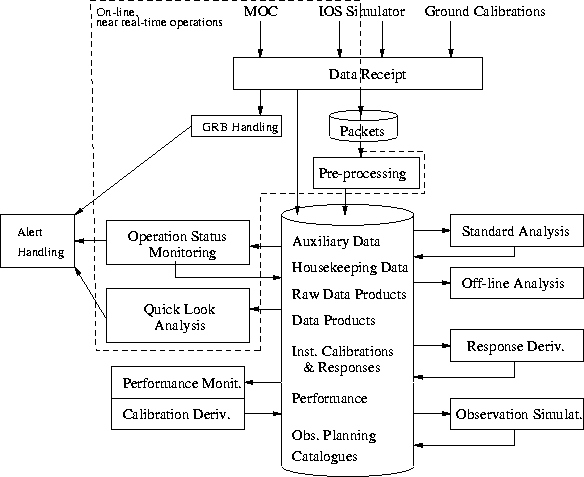Next: Archives and Information Services
Up: Dataflow and Scheduling
Previous: NICMOS Software: An Observation Case Study
Table of Contents -- Index -- PS reprint -- PDF reprint
Roland Walter, Alain Aubord, Paul Bartholdi, Jurek Borkowski,
Pierre Bratschi, Tomaso Contessi, Thierry Courvoisier, Davide Cremonesi,
Pierre Dubath, Donnald Jennings, Peter Kretschmar, Tim Lock,
Stéphane Paltani, Reiner Rohlfs and Julian Sternberg1
INTEGRAL Science Data Centre, Chemin d'Écogia 16, CH-1290 Versoix, Switzerland
1Astrophysics Division, Space Science Department of ESA, ESTEC, 2200 AG Noordwijk, The Netherlands
The International Gamma-Ray Astrophysics Laboratory is a ``medium mission'' of the scientific programme of the European Space Agency (ESA) to be launched in 2001. It was selected to provide the astronomical community with a gamma ray observatory capable of the best possible spectral and angular resolution in order to extend, in the early years of next century, the set of astronomical tools covering the electromagnetic spectrum well into the difficult gamma ray domain.
INTEGRAL will provide both excellent (in terms of gamma ray astronomy) spectral and imaging resolution. The three high energy detectors (the imager IBIS, the spectrometer SPI and the X-ray monitor JEM-X) all use coded mask technology. INTEGRAL will therefore have an angular resolution of ![]() '. The precision of location of a bright point source will be about one arc minute. The spectral resolution will be 2 keV at 500 keV. This will allow astronomers to measure the profiles of gamma ray lines and to measure Doppler shifts within the galaxy. An optical monitoring camera completes the scientific payload.
'. The precision of location of a bright point source will be about one arc minute. The spectral resolution will be 2 keV at 500 keV. This will allow astronomers to measure the profiles of gamma ray lines and to measure Doppler shifts within the galaxy. An optical monitoring camera completes the scientific payload.
Gamma ray astronomy is now one of the tools necessary for the understanding of a wide range of cosmic phenomena, from the study of the interstellar medium to that of active galactic nuclei. It is therefore important to open the observing program to astronomers in the whole community and not to restrict this access to those teams that build the instruments. This is not only necessary for the community in general, but it also ensures that the instruments are used to study the most relevant problems and thus increases the scientific output of the mission. INTEGRAL was therefore conceived from the beginning as an observatory mission.
A gamma ray mission open to the astronomical community at large requires that the data will be calibrated and prepared so as to be understood by non-specialists. This has led to the concept of the INTEGRAL Science Data Centre (ISDC). This centre is the interface between the INTEGRAL data and the users' community. The ISDC is provided by the scientific community (the ISDC consortium). It is hosted by the Observatory of Geneva and started its activities in 1996.
Gamma-ray instruments are complex and the data reduction and calibration rest on a detailed knowledge of the instruments. The INTEGRAL data reduction will therefore be based on instrument specific software modules written by the teams developing and building the instruments.
The main ISDC responsibilities are (a) to receive the telemetry in real time from the Mission Operation Centre, (b) detect gamma-ray bursts within seconds and alert the community, (c) monitor in near real time the health of the scientific instruments and investigate solutions with the instrument teams to resolve problems, (d) perform a quick-look analysis of the data within 10 hours to detect unexpected features and events (TOO), (e) convert the raw data products into physical units, (f) taking into account the instrument characteristics, (g) deduce source properties (images, spectra, light curves) from the observed data, (h) archive the final data product, (i) distribute data and some software and support the users.

The ISDC software system is made of data structures, analysis executables, pipelines and applications.
After a phase of requirement definition, system libraries development and interface specification, the architecture of the ISDC system is being built. Several subsystems will be under development starting early in 1998 and will be integrated and system tested during 1999. Overall tests involving the full ground segment will be conducted during the year 2000.
Additional information on the different elements of the ISDC can be found on the World Wide Web pages of the ISDC (http://obswww.unige.ch/isdc/).
Next: Archives and Information Services
Up: Dataflow and Scheduling
Previous: NICMOS Software: An Observation Case Study
Table of Contents -- Index -- PS reprint -- PDF reprint